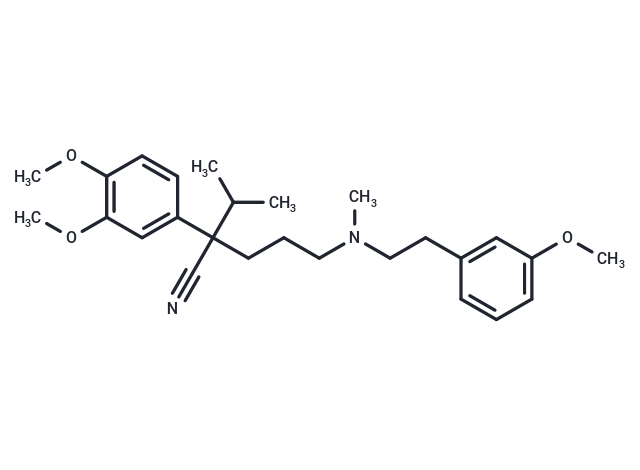
Devapamil
CAS No. 92302-55-1
Devapamil( —— )
Catalog No. M36157 CAS No. 92302-55-1
Devapamil (Devapamilo) is a phenylalkylamine that blocks L-type calcium currents from the inner side of membrane cells in a use-dependent manner.
Purity : >98% (HPLC)
 COA
COA
 Datasheet
Datasheet
 HNMR
HNMR
 HPLC
HPLC
 MSDS
MSDS
 Handing Instructions
Handing Instructions
| Size | Price / USD | Stock | Quantity |
| 2MG | 122 | Get Quote |


|
| 5MG | 171 | Get Quote |


|
| 10MG | 247 | Get Quote |


|
| 25MG | 466 | Get Quote |


|
| 50MG | 626 | Get Quote |


|
| 100MG | 871 | Get Quote |


|
| 500MG | 1737 | Get Quote |


|
| 1G | Get Quote | Get Quote |


|
Biological Information
-
Product NameDevapamil
-
NoteResearch use only, not for human use.
-
Brief DescriptionDevapamil (Devapamilo) is a phenylalkylamine that blocks L-type calcium currents from the inner side of membrane cells in a use-dependent manner.
-
DescriptionDevapamil (Devapamilo) is a phenylalkylamine that blocks L-type calcium currents from the inner side of membrane cells in a use-dependent manner.
-
In Vitro——
-
In Vivo——
-
Synonyms——
-
PathwayGPCR/G Protein
-
TargetCalcium Channel
-
RecptorCalcium Channel
-
Research Area——
-
Indication——
Chemical Information
-
CAS Number92302-55-1
-
Formula Weight424.58
-
Molecular FormulaC26H36N2O3
-
Purity>98% (HPLC)
-
Solubility——
-
SMILESC(CCCN(CCC1=CC(OC)=CC=C1)C)(C(C)C)(C#N)C2=CC(OC)=C(OC)C=C2
-
Chemical Name——
Shipping & Storage Information
-
Storage(-20℃)
-
ShippingWith Ice Pack
-
Stability≥ 2 years
Reference
molnova catalog



related products
-
Calcium Channel anta...
Calcium Channel antagonist 2 is a calcium channel antagonist (IC50=5-20 μM) that can be used to study diseases due to Ca2+ channels like pain and diabetes.
-
Levamlodipine
Levamlodipine also known as S-amlodipine is a pharmacologically active enantiomer of amlodipine an antihypertensive and anti-anginal medication.
-
Amlodipine
Amlodipine is a long-acting calcium channel blocker.



 Cart
Cart
 sales@molnova.com
sales@molnova.com


